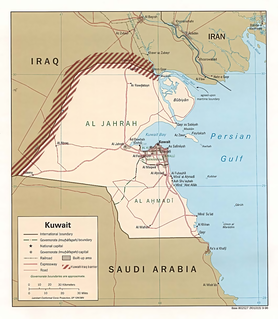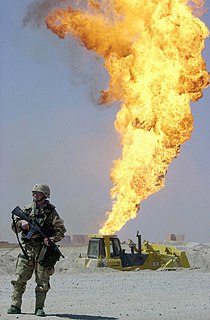 W
WThe Battle of Kuwait International Airport occurred on February 27, 1991 during the 1st Gulf War. It was a tank battle between the United States and Iraq. Despite being a very large battle it is often overlooked compared to the other battles which took place during the war. No less than elements of 18 divisions total participated in this battle. U.S. Army Special Forces units and multiple Iraqi Commando units were also in theatre. In reality the battle took place over a span of three days despite the primary battle at Kuwait International Airport lasting only one day. Much of the combat actually took place en route to the airport. The battle featured the "Reveille Engagement" which went on to become the biggest and fastest tank battle in United States Marine Corps' entire history.
 W
WThe Liberation of Kuwait was a U.S.-led military operation to retake Kuwait from Iraq after the massive air campaign, between 24–28 February 1991. U.S. troops and the Coalition entered to find the Iraqis surrendering en masse; however, pockets of resistance existed, particularly at Kuwait International Airport where Iraqi troops, seemingly unaware that a retreat order had been issued to them, continued to fight, resulting in a fierce battle over the airport itself. The majority of the fighting took place in Iraq, rather than Kuwait. The operation is part of what is commonly known as the Gulf War.
 W
WThe Gulf War was a war waged by coalition forces from 35 nations led by the United States against Iraq in response to Iraq's invasion and annexation of Kuwait arising from oil pricing and production disputes. It was codenamed Operation Desert Shield for operations leading to the buildup of troops and defense of Saudi Arabia and Operation Desert Storm in its combat phase.
 W
WThe Gulf War oil spill, or the Persian Gulf oil spill, was one of the largest oil spills in history, resulting from the Gulf War in 1991. In January of 1991, Iraqi forces allegedly began dumping oil into the Persian Gulf to stop a United States (US) water landing on their shores. Despite quite high initial estimates, the spill likely was about 4,000,000 US barrels. Within the following months of the spill, most clean-up was targeted at recovering oil, and very little clean-up was done on Saudi Arabia’s highly-affected beaches. An initial study in 1993 found that the spill will not have long-term environmental consequences, but many studies since 1991 have concluded the opposite, claiming that the spill is responsible for environmental damage to coastline sediments and marine species and ecosystems. Considered an act of eco-terrorism, the spill was a heated political move that had implications for the larger Gulf War and temporarily damaged Kuwait and Saudi Arabia’s economies.
 W
WThe Highway of Death is a six-lane highway between Kuwait and Iraq, officially known as Highway 80. It runs from Kuwait City to the border town of Safwan in Iraq and then on to the Iraqi city of Basra. The road was used by Iraqi armored divisions for the 1990 Invasion of Kuwait. It was repaired after the Persian Gulf War and used by U.S. and British forces in the initial stages of the 2003 invasion of Iraq.
 W
WThe Kuwaiti oil fires were caused by Iraqi military forces setting fire to a reported 605 to 732 oil wells along with an unspecified number of oil filled low-lying areas, such as oil lakes and fire trenches, as part of a scorched earth policy while retreating from Kuwait in 1991 due to the advances of US-led coalition forces in the Persian Gulf War. The fires were started in January and February 1991, and the first well fires were extinguished in early April 1991, with the last well capped on November 6, 1991.
 W
WThe Package Q Airstrike was the largest airstrike of the Persian Gulf War, and the largest strike of F-16s in military history. Many aircraft including the F-117 were used to attack targets in Baghdad, which was the most heavily defended area of Iraq. The same target was hit several times by F-117, and the last package consisted of seventeen F-111F on the 19th day of the war.
 W
WThe Palestinian exodus from Kuwait took place during and after the Gulf War. There were 400,000 Palestinians in Kuwait before the Gulf War. During the Iraqi occupation of Kuwait, 200,000 Palestinians left Kuwait due to various reasons. After the Gulf War of 1991, nearly 200,000 Palestinians fled Kuwait, partly due to economic burdens, regulations on residence and fear of abuse by Kuwaiti security forces. The policy which partly led to this exodus was a response to the alignment of PLO leader Yasser Arafat with Saddam Hussein.
 W
WUnited Nations Security Council resolution 686, adopted on 2 March 1991, after reaffirming resolutions 660, 661, 662, 664, 665, 666, 667, 669, 670, 674, 677 and 678, the Council noted the suspension of military activities against Iraq and that all twelve resolutions continue to have full force and effect.
 W
WUnited Nations Security Council Resolution 687, adopted on 3 April 1991, after reaffirming resolutions 660, 661, 662, 664, 665, 666, 667, 669, 670, 674, 677, 678 and 686 (1991), the Council set the terms, in a comprehensive resolution, with which Iraq was to comply after losing the Gulf War. Resolution 687 was passed by 12 votes to one against (Cuba) with two abstentions from Ecuador and Yemen after a very extended meeting. Iraq accepted the provisions of the resolution on 6 April 1991.
 W
WUnited Nations Security Council resolution 689, adopted unanimously on 9 April 1991, after recalling Resolution 687 (1991), the Council noted a report by the Secretary-General and decided to establish the United Nations Iraq–Kuwait Observation Mission to monitor the demilitarized zone between Iraq and Kuwait, known as the Kuwait–Iraq barrier.
 W
WUnited Nations Security Council resolution 692, adopted on 20 May 1991, after recalling resolutions 674 (1990), 686 (1991) and 687 (1991), as well as taking the report by the Secretary-General, the Council decided to establish the United Nations Compensation Commission to deal with compensation claims resulting from Iraq's invasion of Kuwait, which subsequently led to the Gulf War.
 W
WUnited Nations Security Council resolution 706 decided on a mechanism to allow Iraq to sell oil in return for humanitarian aid from Member States. The Council, acting under Chapter VII, adopted the resolution on 15 August 1991, after recalling resolutions 661 (1990), 686 (1991), 687 (1991), 688 (1991), 692 (1991), 699 (1991) and 705 (1991). The provisions of Resolution 706 functioned in a way similar to that which was later implemented in the Oil-for-Food Programme under Resolution 986 in 1995.